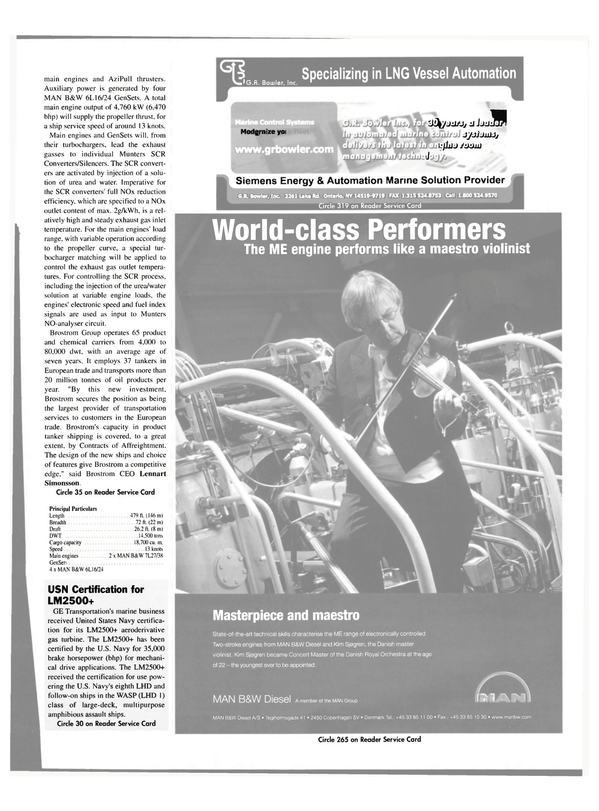
Canadian Towing Firm Refits for the Future
"It is exciting to see our vessels coming and going through the harbor. I particularly enjoy that fact that we appear to be one of the busiest, and best looking fleets on the water," says Island Tug and Barge Ltd. President Bob Shields of the view from his harbor side office in Vancouver, BC. Capt. Shields has built a reputation as an innovator in an innovative British Columbia towboating market.
This reputation was enhanced last year when Shields and his partner, Capt Jack Davies, retrofitted an Intercon connector to their 41.5 by 9.8-m, 3,000- hp twin-screw tug Island Monarch.
Now, a year later, Vancouver waterfront watchers are seeing the company repower its classic raised-focsle style Island Crown with a pair of Cummins KTA38.
The 23.7 x 7.3-m Island Crown is one of those distinctively Canadian tugs whose raised focsle design resulted from a requirement that all crews' quarters must be above the waterline. Built in 1974 to a Robert Allan design, she was first Christened the Gulf Julia. Later, renamed the Seaspan Defender she has more than earned her keep over the past three decades towing along the Pacific coast. But this was a well designed and well built boat and her owners felt secure in doing a routine repower to extend her life. An old pair of 725 hp engines pulled out and replaced with the new Cummins KTA38M0 engines. The new engines have been de-rated to 500 hp each at 1,600 rpm but are designed capable of 800 hp each at 1,800 rpm.
The existing Twin Disc TD540 7:1 marine gears were sent out for rebuilding and were reinstalled. The threeblade propellers in nozzles were kept to their original 74 x 78-in. dimensions.
"We had Robert Allan Ltd. do a complete engineering study for us on the repowering and were amazed to discover that the propellers were an absolute perfect match for the two ratings of the Cummins engines," Shields said. "We didn't do a bollard pull test, but believe we are getting slightly better performance than prior to the re-power. We estimate the bollard pull at 36,500 lbs at the 500 hp rating and 57,750 lbs at the 800 hp rating." While the engine selection and preparation was a detailed and intense process, the actual lowering of the two 9,000 pound engines was accomplished in a solid morning of work. A well-coordinated team that worked with a rented crane to lower the machinery through a hatch in the top of the fiddley. The engines, lifted with a specially designed jig, were stood on their head to fit through the hatch with inches to spare. The gears followed and were mated to the engines and shafts.
Circle 28 on Reader Service Card
Read Canadian Towing Firm Refits for the Future in Pdf, Flash or Html5 edition of September 2004 Maritime Reporter
Other stories from September 2004 issue
Content
- SSI Concerns Continue page: 5
- Signed Confessions page: 9
- OMI to Pay $4.2M for Waste Oil Dumping page: 14
- NASSCO Delivers Alaskan Frontier page: 17
- Alabama Shipyard to Build Hopper Dredge page: 17
- Merwede Tapped for Navy, Commercial Contracts page: 18
- FBM Babcock Wins U.S. Contract page: 19
- New Vessels from VT Halmatic page: 19
- ABCO Launches Three New Boats page: 20
- IR Generates $64M in Orders page: 24
- Sideways to Swimmers: Unusual Tank Testing page: 26
- Current Uses of FEA in Shipbuilding page: 30
- BMT Aims to Improve Vessel Evac page: 32
- Flensburg Makes its Mark Again page: 36
- SMM 2004: Ready for the World page: 36
- German Shipyards Propose Merger page: 37
- Voith to Exhibit VWT Baut at SIMM page: 37
- Blohm + Voss Repair Wins Business page: 38
- Methane Arctic Benefits from German Technology page: 39
- Becker Kort Rudder Nozzles for Improved Maneuverability page: 40
- Payer Presented Cross of the Order of Merit page: 42
- Xantic: Focus on Integrated Solutions page: 44
- A Benchmark in Electronic Fuel Injection page: 45
- Q&A with Wartsila CTO Matti Kleimola page: 46
- Seacor Crewboats "Eliminators" Some Maintenance Costs page: 49
- (Fuel) Cells of Endeavor page: 50
- Containerships: When Will One Engine Not Be Enough? page: 52
- Most Powerful Common- Rail Engine Passes Test page: 54
- Clean Concept for Brostrom Tankers page: 54
- Canadian Towing Firm Refits for the Future page: 56
- TOR: The Next-Generation Turbocharger page: 57
- Duramax Marine Creates Largest Ever DuraCooler page: 58
- ABS: Large Ship Hull Deflections Impact the Shaft Alignment page: 60
- The Great Maritime Disruption... that Never Happened page: 66
- New Positioning Technique Helps Cut Costs in Deepwater GOM page: 76
- U.S. Ferry Market Prospects Looking Up page: 77
- "Ship Design and Construction" page: 81


